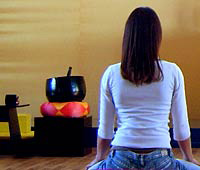How can I live what I believe?
By Bree Buchanan ♦ Because you are reading this, I am willing to wager that you are someone who has struggled with the question, “How can I live what I believe?” If so, we have much in common. My Christian faith tells me to “love my neighbor as I love myself,” but I need support in putting this directive into action. Our frantic, time-obsessed, goal-focused society leaves neither the space nor the energy to provide the kind of grace-filled compassion that we need for loving interaction with those we encounter.
So it was that at a time of great crisis in my life, when I had very little compassion for myself much less my fellow man, I went searching for a faith tradition and community that would provide an antidote to my despair. Ultimately, I found my way to the Austin Shambhala Meditation Center, seeking answers to the questions of how do I love myself and how do I love all of these other people who are driving me crazy!
Shambhala, a secular Western form of Tibetan Buddhism, is a tradition whose path is to help create and maintain an enlightened society. It is founded on the belief that “there is a natural source of radiance and brilliance in the world, which is the innate wakefulness of human beings.” As Shambhala is secular and open to individuals of any or no religion, it posed no barriers to my participation as one who believes in divine power greater than myself. There, I learned the practice of mindfulness meditation which is taught as a means of connecting with one’s inherent goodness as a source of inspiration for one’s compassionate encounter with the world. The core teachings are based upon the idea that, if I can recognize my own goodness, I can bring that awareness into all of my interactions.
I began to practice meditation daily and, in doing so, began to learn how to recognize the good in myself and those around me. As my despair lifted, I began to consider and question how this tradition, one that aspires to the creation of an enlightened society, was bringing this goal to fruition. As a lifelong seeker and sampler of faiths, I have considered a religious institution’s commitment to service of others, especially those afflicted by illness, poverty or disaster, to be the litmus test of whether they “practice what they preach.” I began to ask, “What is Shambhala doing for the community?” This question came out of my experience of religious, social and civic organizations’ public service projects, ones that were performed on a set day for a specified period of time and in a discrete setting.
The answer: Shambhala takes a different view towards the creation and maintenance of an enlightened society, a view so expansive that it took me several years to fully appreciate the radical effect that it can have on one’s life and others. The impetus is placed on extending kindness, compassion and understanding into every aspect of life which includes family, friends, work, social activities; in fact, every action taken throughout the day. The Shambhala vision is that through the practice of meditation, we can strengthen our awareness so that we can work from within to engender service to others as a way of life.
Every day, often minute to minute, I still struggle with the challenge of engaging with the world in this way. Because I so often am not able to fulfill this ideal, my socio-cultural conditioning compels to believing that I am simply inherently flawed. But, in Shambhala, the view is one of gentleness, kindness to self and of “no big deal.” Every moment is new, uncluttered by regret for actions that missed the mark. Each moment is ripe with fresh opportunity to be kind, to be open to the world with a loving heart.


